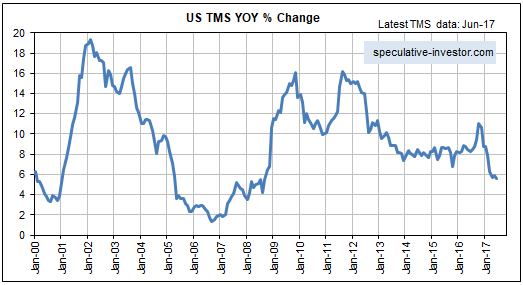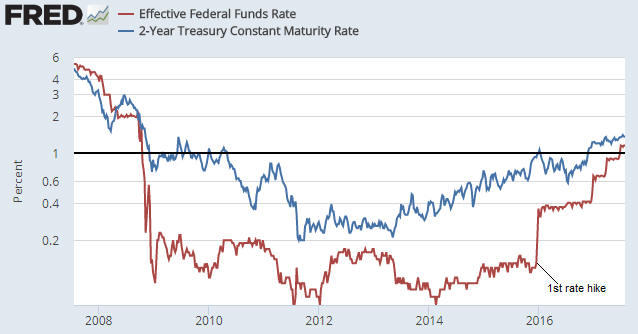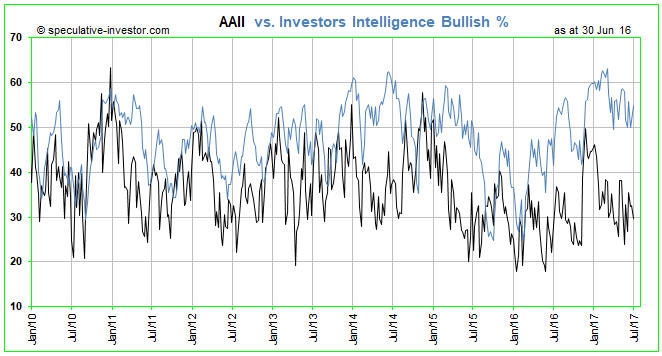Globalisation, a term that when used in economics refers to the integration of national economies into a global marketplace, is perceived to be part of the reason for economic weakness in some countries. This is a perception that the politically-astute feed upon, often by invoking the “we” fallacy.
According to the “we” fallacy, anyone who happens to be located inside an arbitrary border is one of “us” and deserves preferential treatment at the expense of anyone who happens to be located outside the border. The “we” fallacy underpins the concerns that are routinely expressed about trade deficits, the thinking being that “we” are being hurt because “they” sell more stuff to us than we sell to them*.
To expose the flawed logic that initially leads to teeth-gnashing over trade deficits and subsequently leads to protectionist trade policies, I’ll use a hypothetical example involving two pig farmers (Bill and Bob) and a butcher (Arthur). Bill, Bob and Arthur live and work in a small US town located 1 mile south of the US-Canada border. Bill is a more efficient pig farmer than Bob and is thus able to sell his pigs at a 10% lower price. Consequently, Arthur buys twenty pigs per year from Bill and none from Bob. This arrangement continues for several years, at which point Bill decides to move his farm 2 miles to the north (to the other side of the US-Canada border).
Business-wise, nothing changes and Arthur continues to buy 20 pigs per year from Bill. However, due to the minor change in the physical location of Bill’s farm the business that Bill and Arthur have been conducting for many years now adds to the US trade deficit. In other words, a business relationship that nobody was previously concerned about suddenly becomes a problem for the collective “we”, even though nothing has really changed. Bob, sensing an opportunity, complains to the US government that he will have to fire his farmhand unless something is done to prevent his business from being undercut by cheap imports. In response, the US government slaps a 15% tariff on Canadian pigs, prompting Arthur to start using Bob as his pig supplier.
In this hypothetical example Bob has clearly benefited from the government’s interference in the pig market, but only at Arthur’s expense. Arthur is now forced to pay 10% more for his pigs, which will either cut into his profits — and, perhaps, curtail his plans to invest in the growth of his business — or cause him to raise his prices. Whatever happens, Bob’s gain will be matched by the loss incurred by other people within the US. In other words, the US “we” will not actually benefit, even in the unlikely event that the Canadian government doesn’t take counter-measures in an effort to protect its own collective “we”.
In the same way that the overall US economy failed to benefit from the pig tariff in my hypothetical example, “we” can never benefit from policies that restrict international trade. This is because from an economics perspective there is no “we”, there are just individuals trading with each other for their mutual benefit. A consequence is that when measures are taken by the government to protect the collective “we”, what actually results is the artificial creation of both winners and losers. The benefits gained by some individuals within the economy will be offset by the losses of others within the same economy.
The upshot is that protectionist measures are, at best, a zero-sum game, although in most cases they will turn out to have a net-negative effect on the ‘protected’ economy because they will interfere with price signals, keep inefficient businesses alive, and generally make both the cost of doing business and the cost of living higher than would otherwise be the case.
Protectionist measures are often popular, though, especially during hard economic times. Here’s why:
First, you generally need only a superficial understanding of economics to see the immediate and direct effects of a policy, whereas a deeper understanding of economics is often required to see the long-term and indirect effects. Very few people have this deeper understanding, so all they see are the immediate and direct effects of protectionism, which could be positive.
Second, the immediate benefits of the protectionist policy are typically concentrated, whereas the costs are widely spread. As a result, a politician can adopt a protectionist stance to gain the support of the relatively small number of people who are advantaged without losing the support of the much larger number of people who are disadvantaged. It’s an example of robbing Peter to pay Paul, where Paul notices and Peter doesn’t.
Third, when things are obviously going wrong it’s convenient to point the finger of blame outward at “them”. It certainly beats trying to identify the real source of the problem when doing so would lead to the finger of blame being pointed inward.
I guess we should be thankful that the same flawed logic that is often applied to international trade is usually not applied to interstate trade and is never applied to trade between towns, neighbourhoods and individuals within the same state, because if it were then there would be a lot less trade and a lot less wealth. The only reason the flawed logic isn’t applied at a more micro level is that the collective “we” is arbitrarily defined as everyone on a particular side of a country border.
*Refer to my 13th February blog post for an explanation of why a trade deficit is never a problem.
 Print This Post
Print This Post



